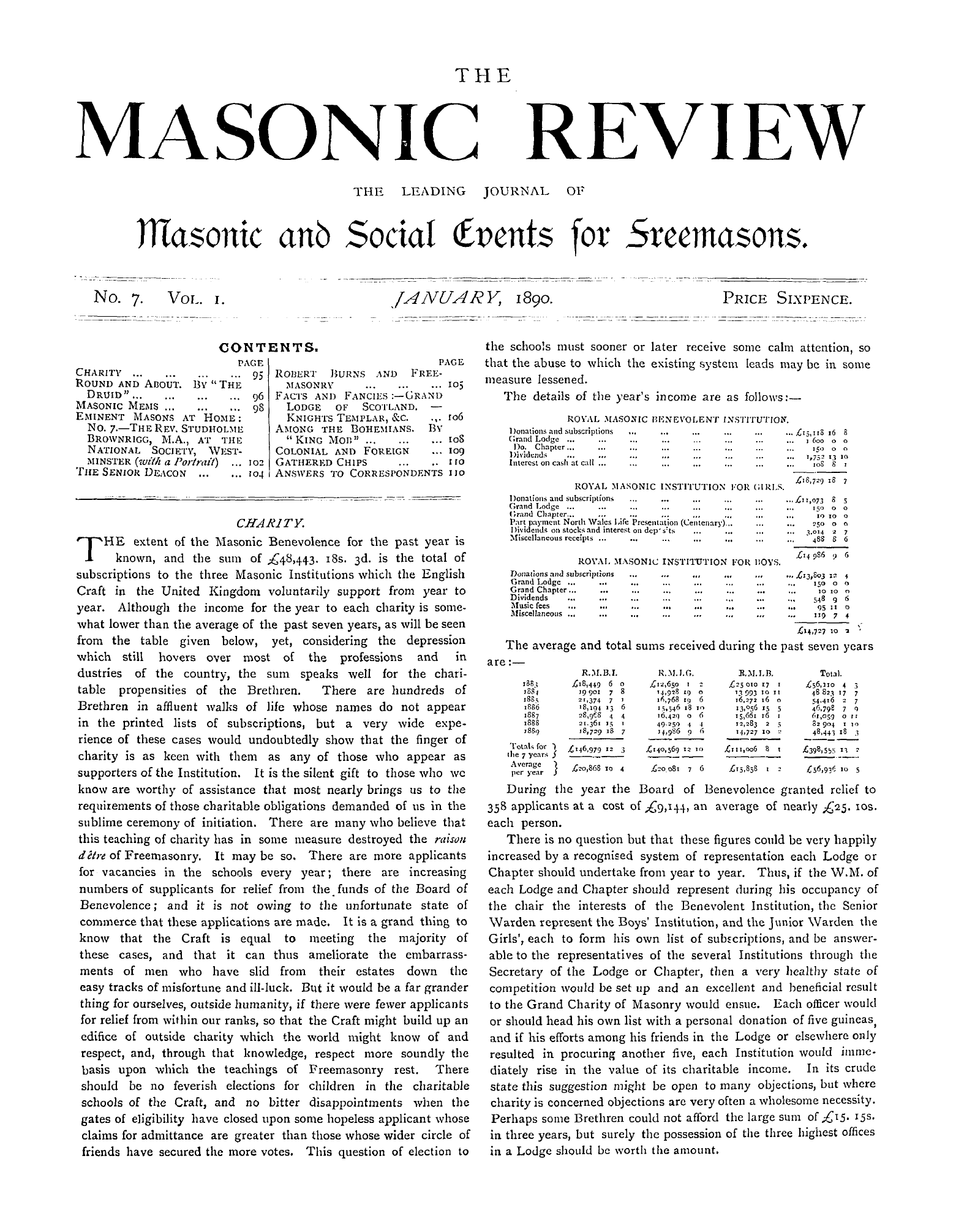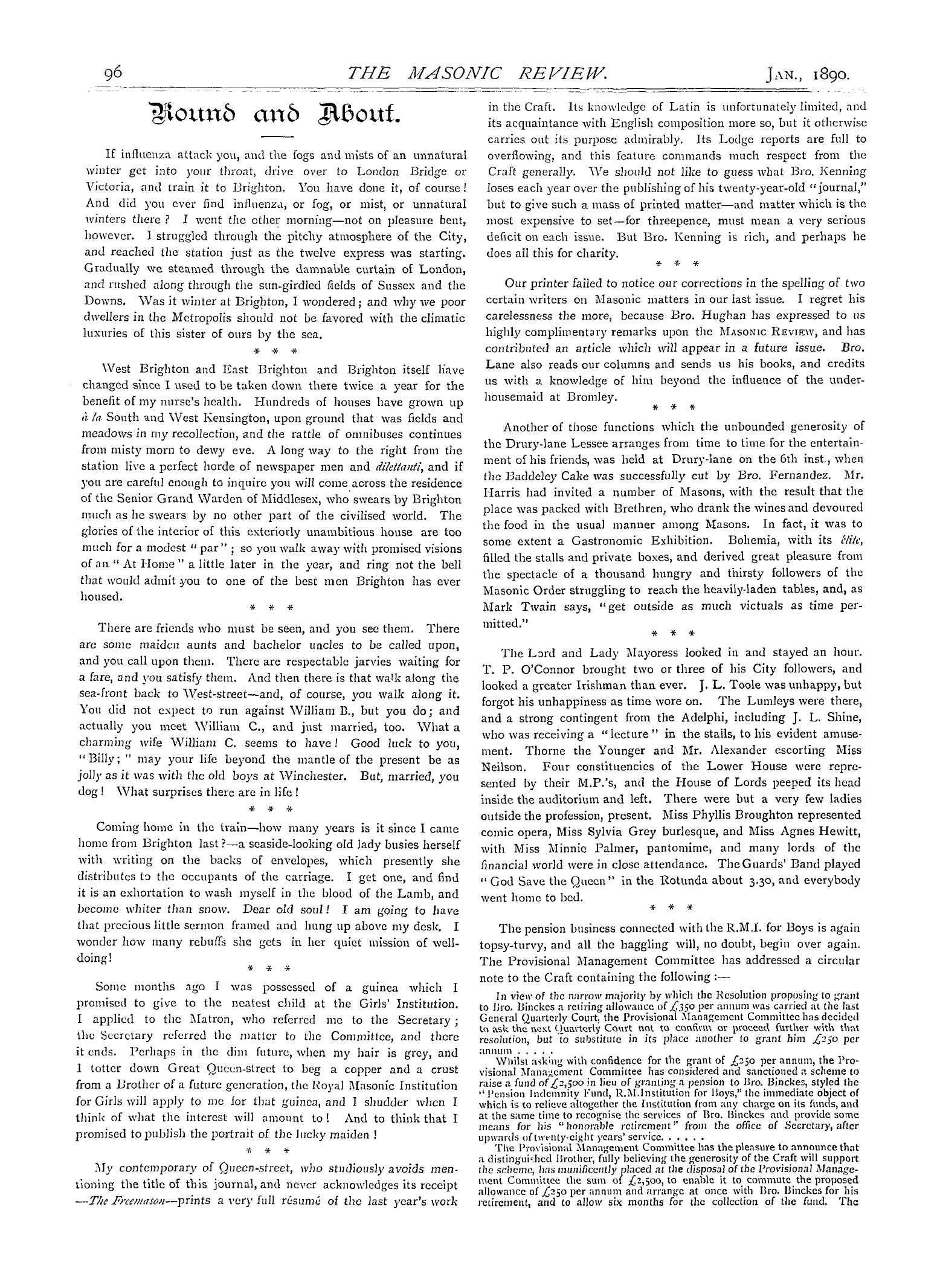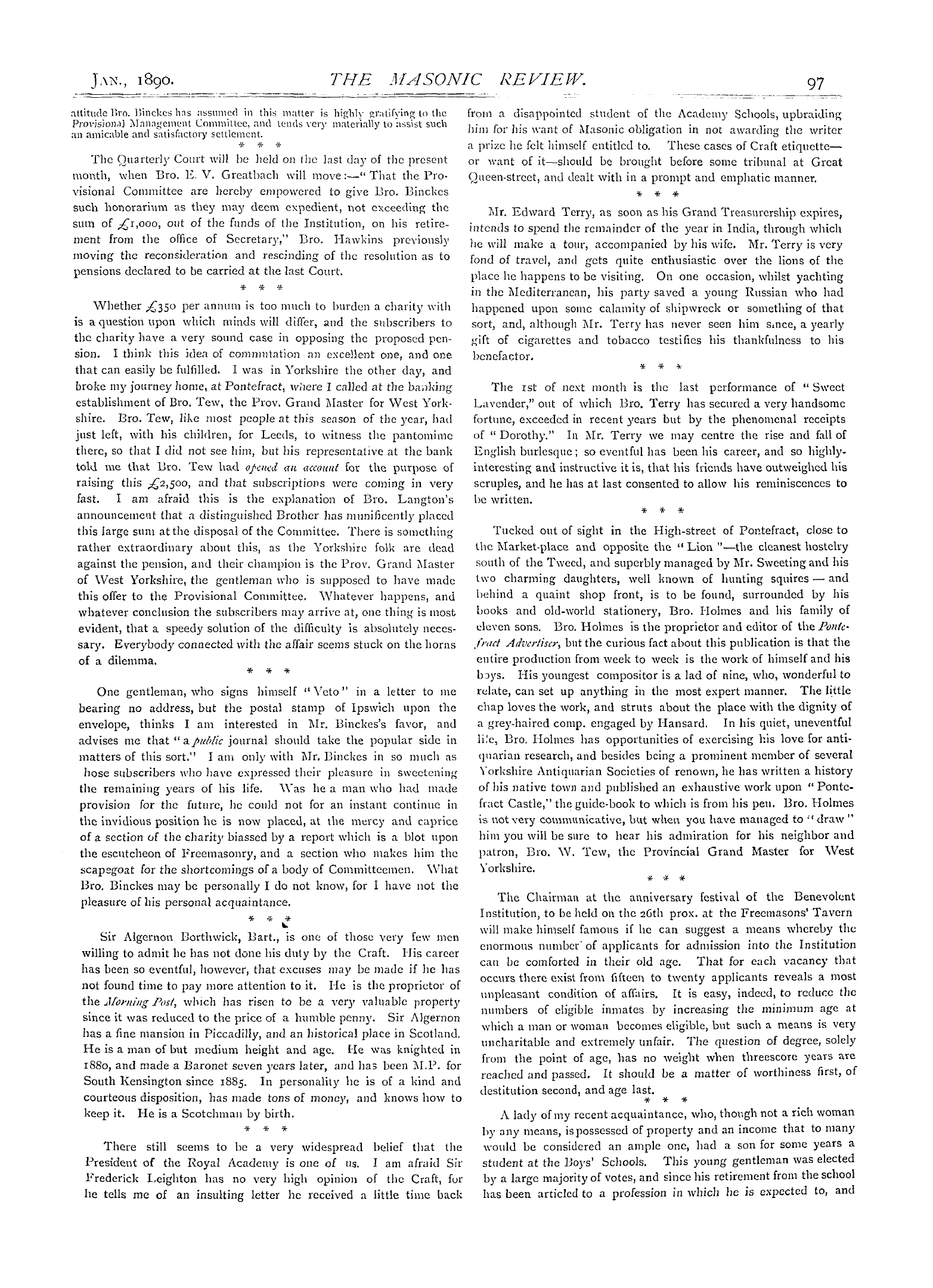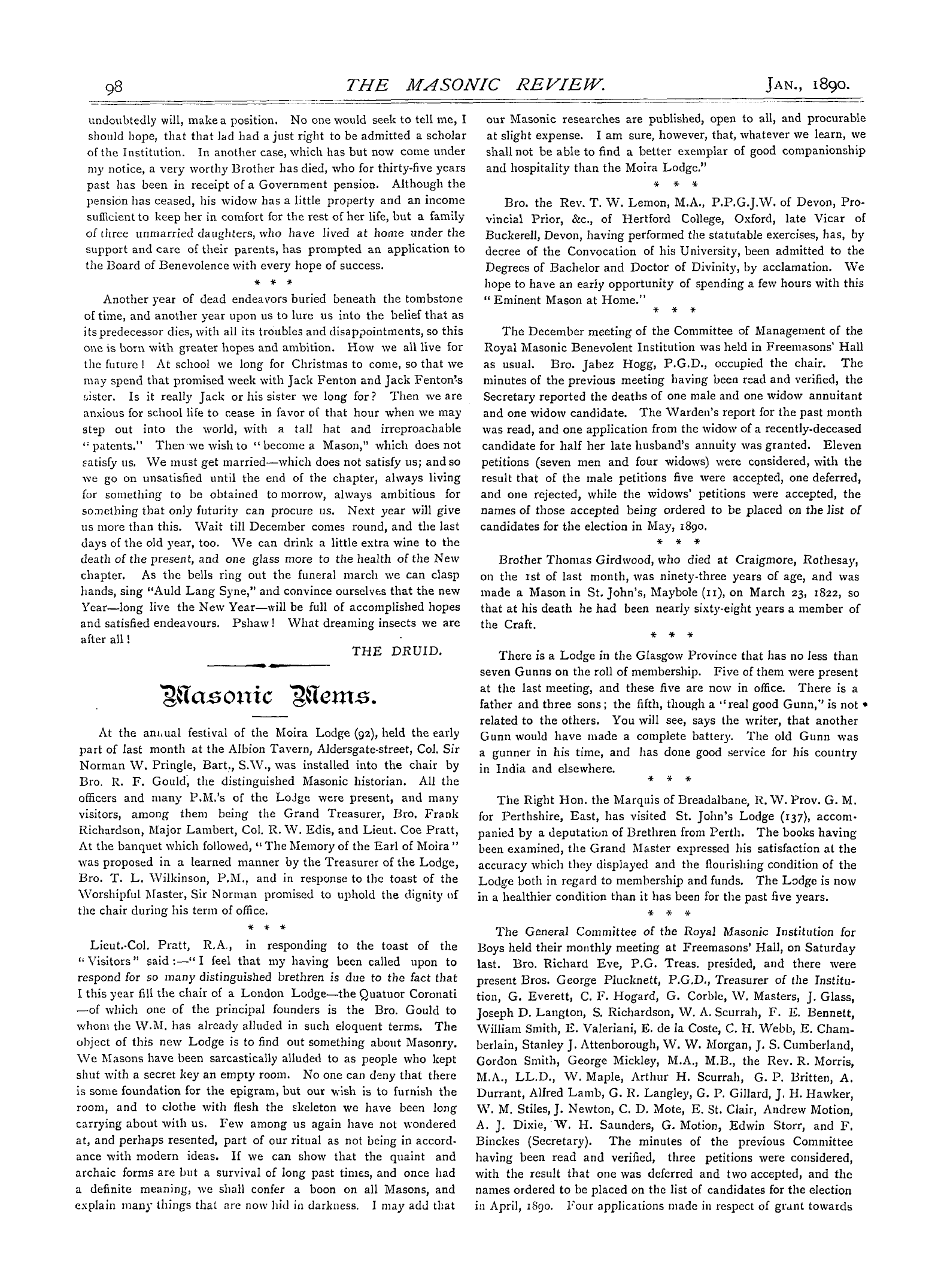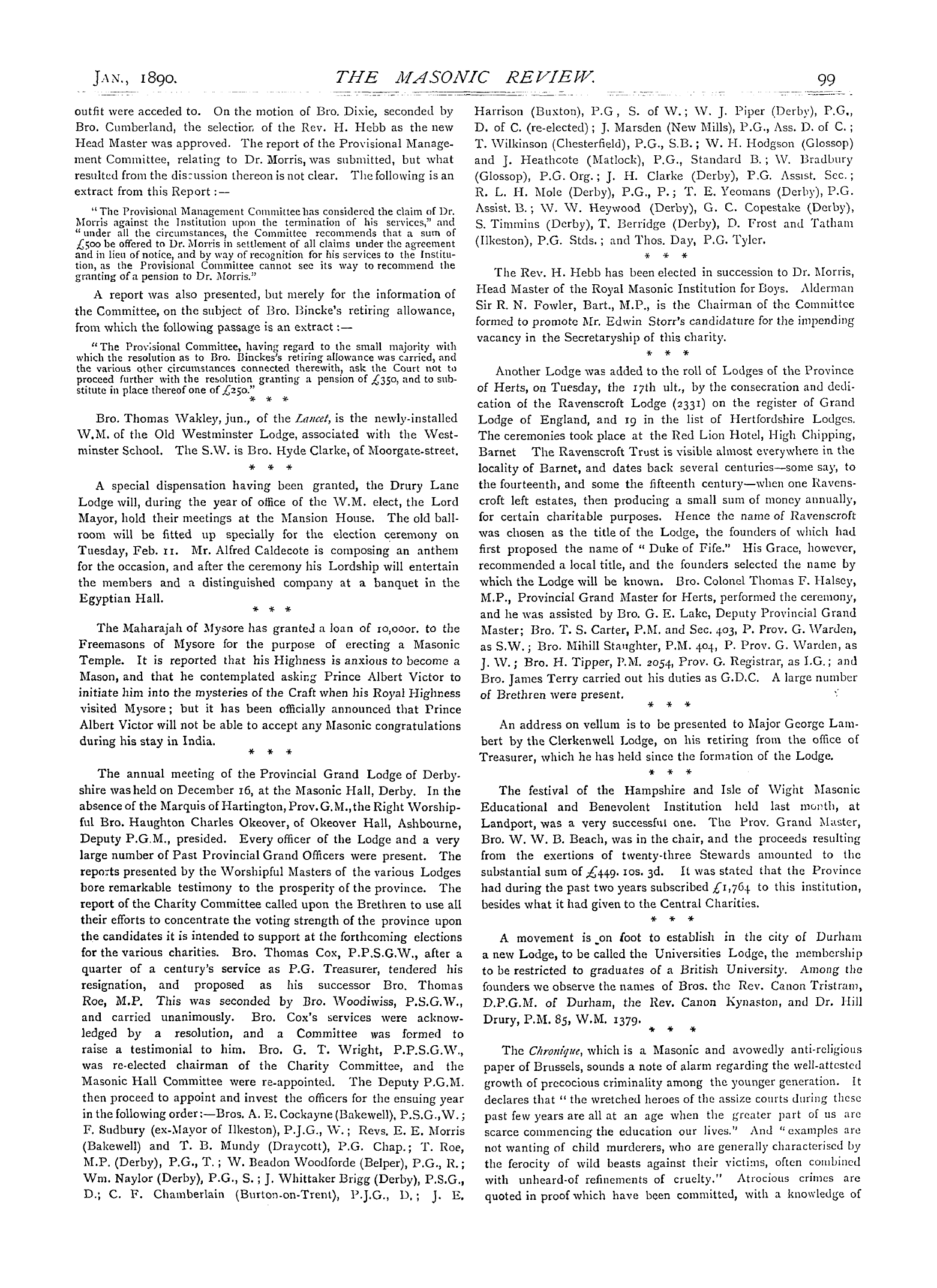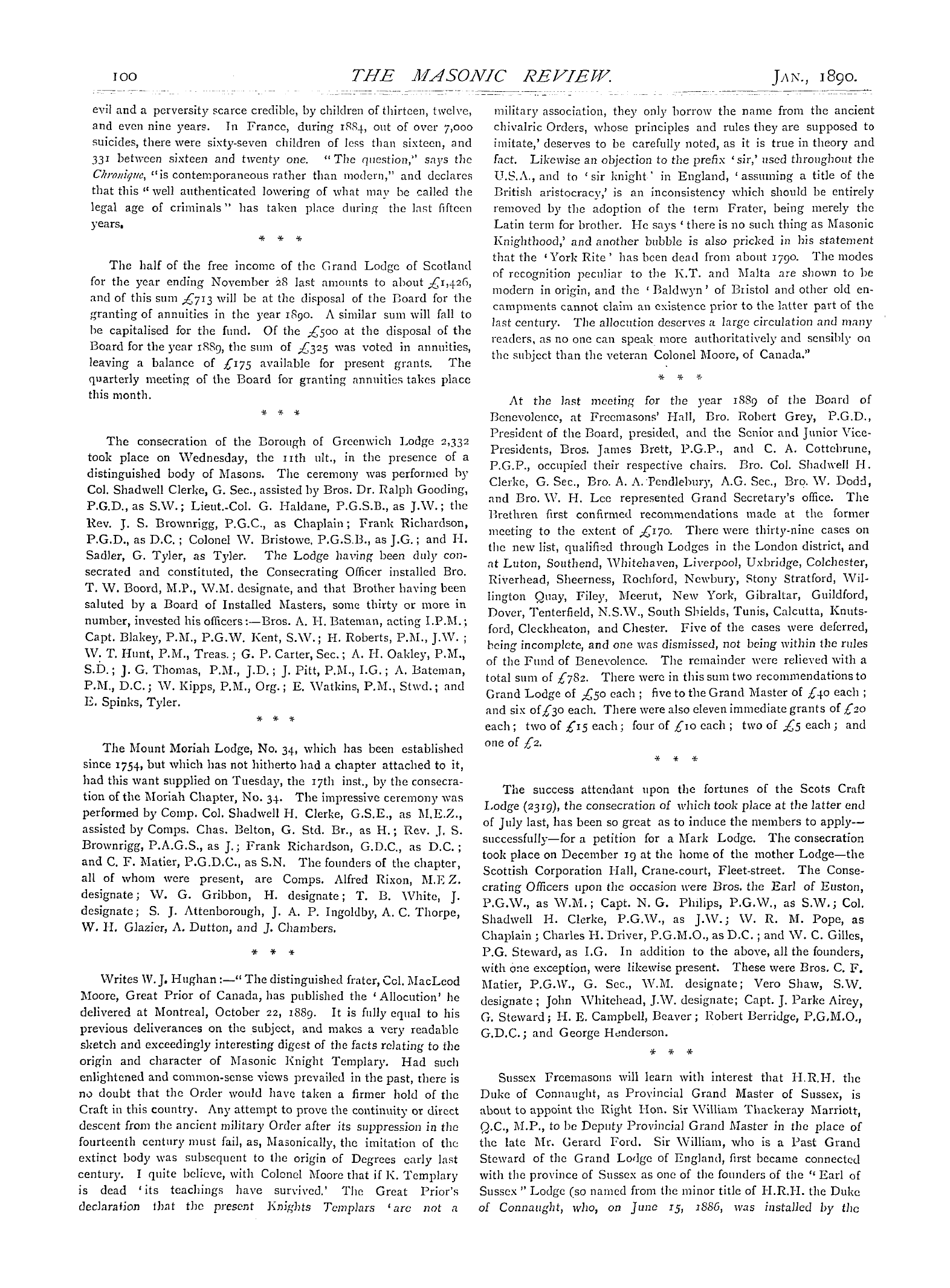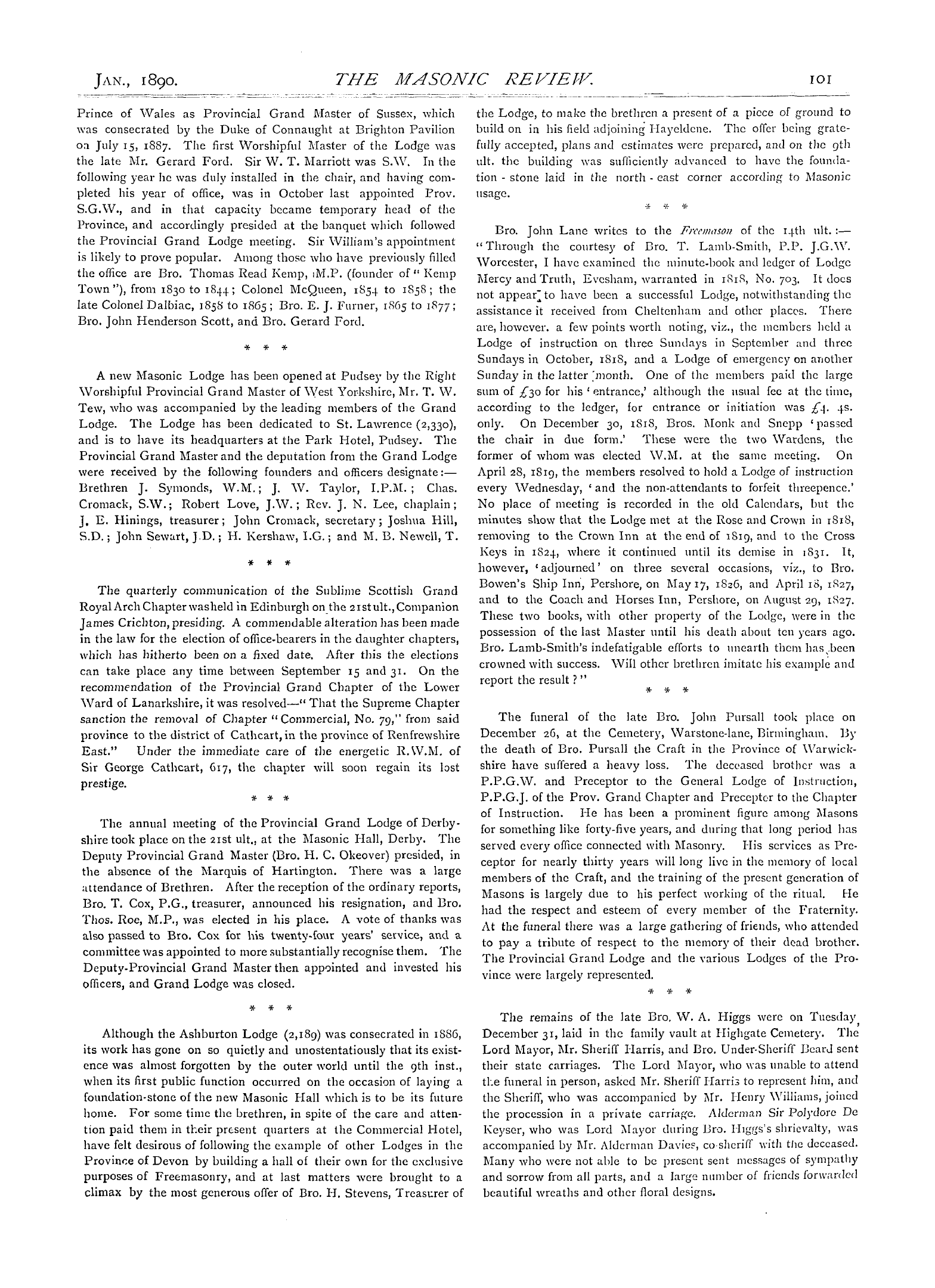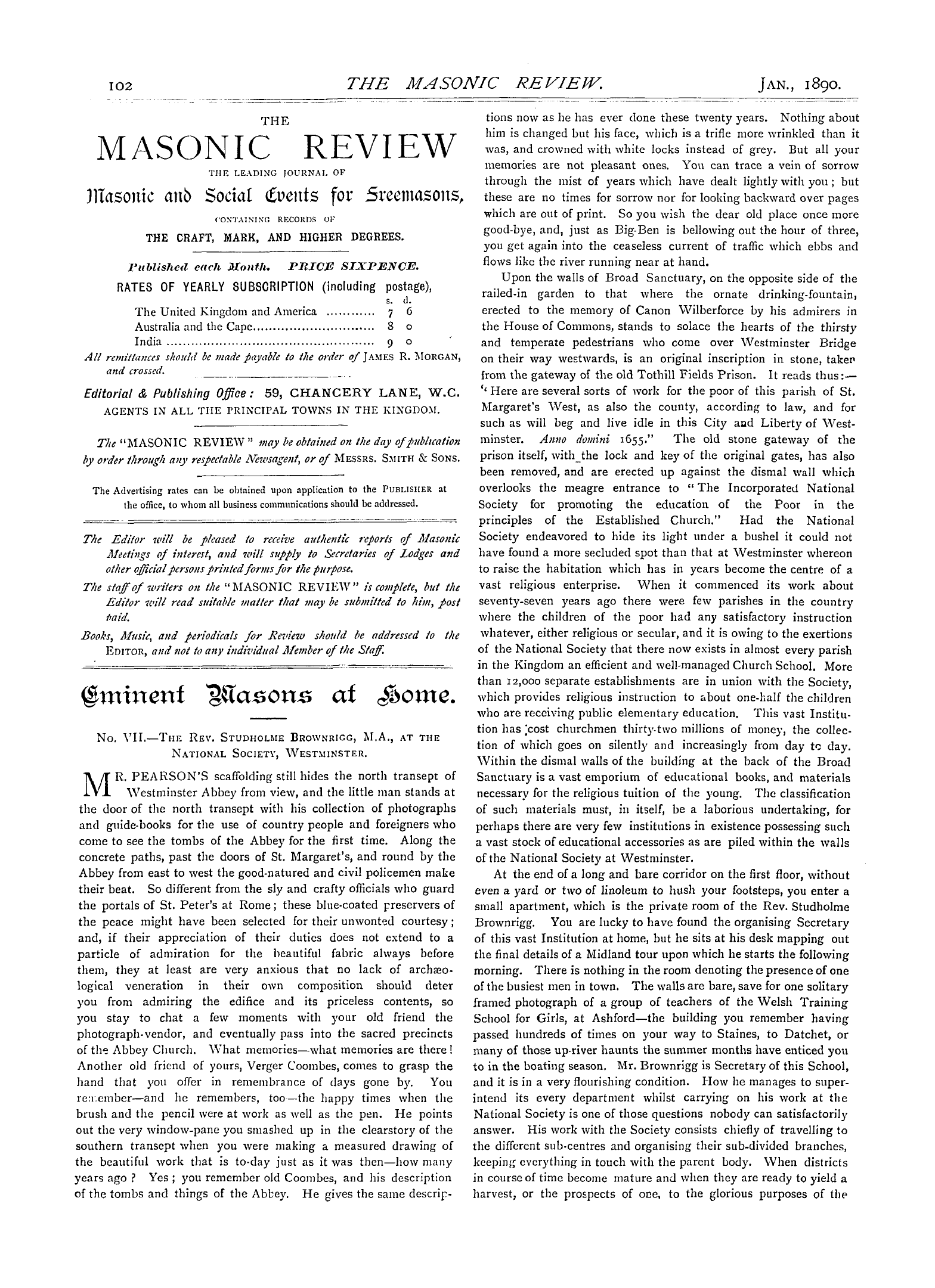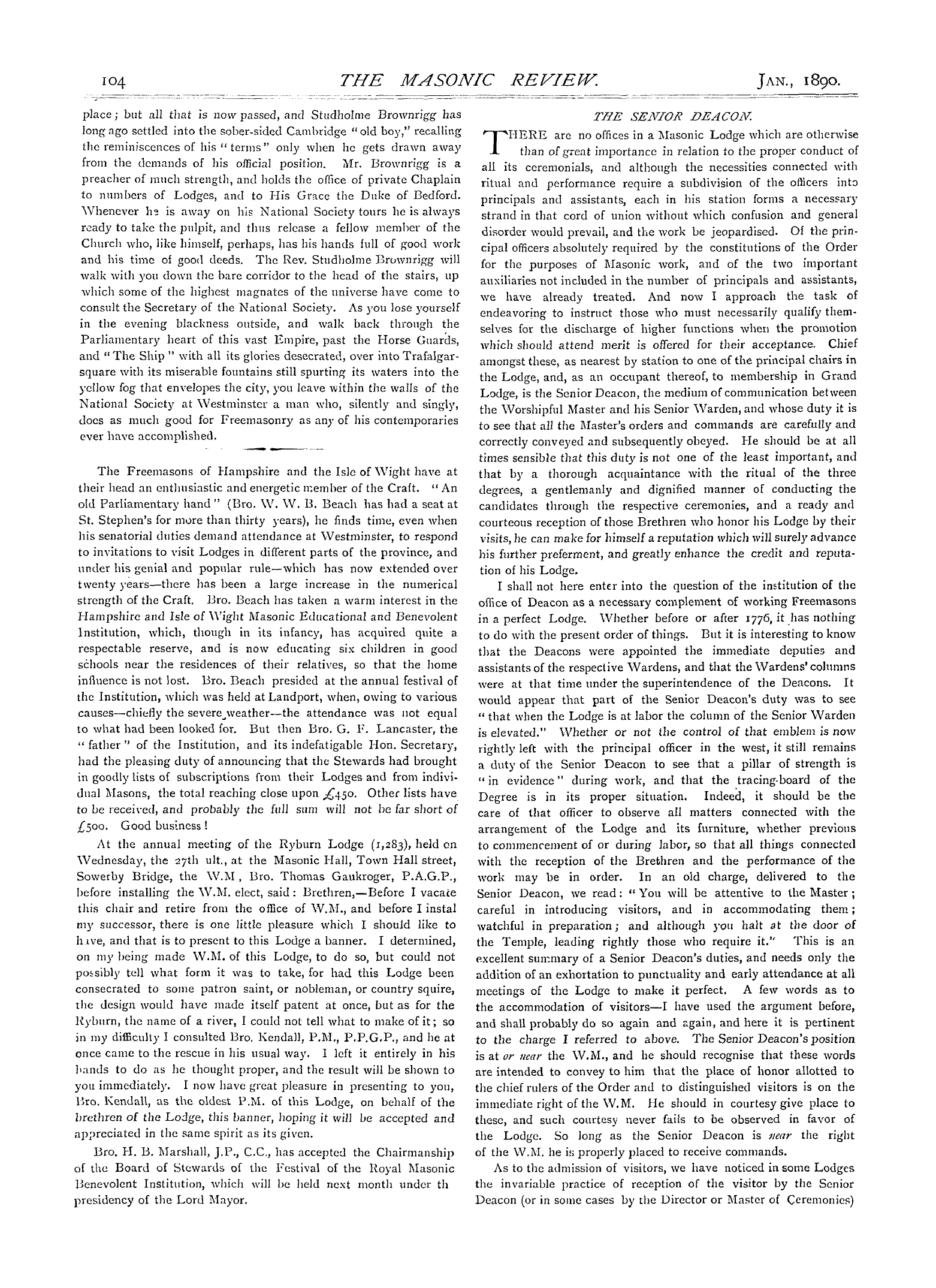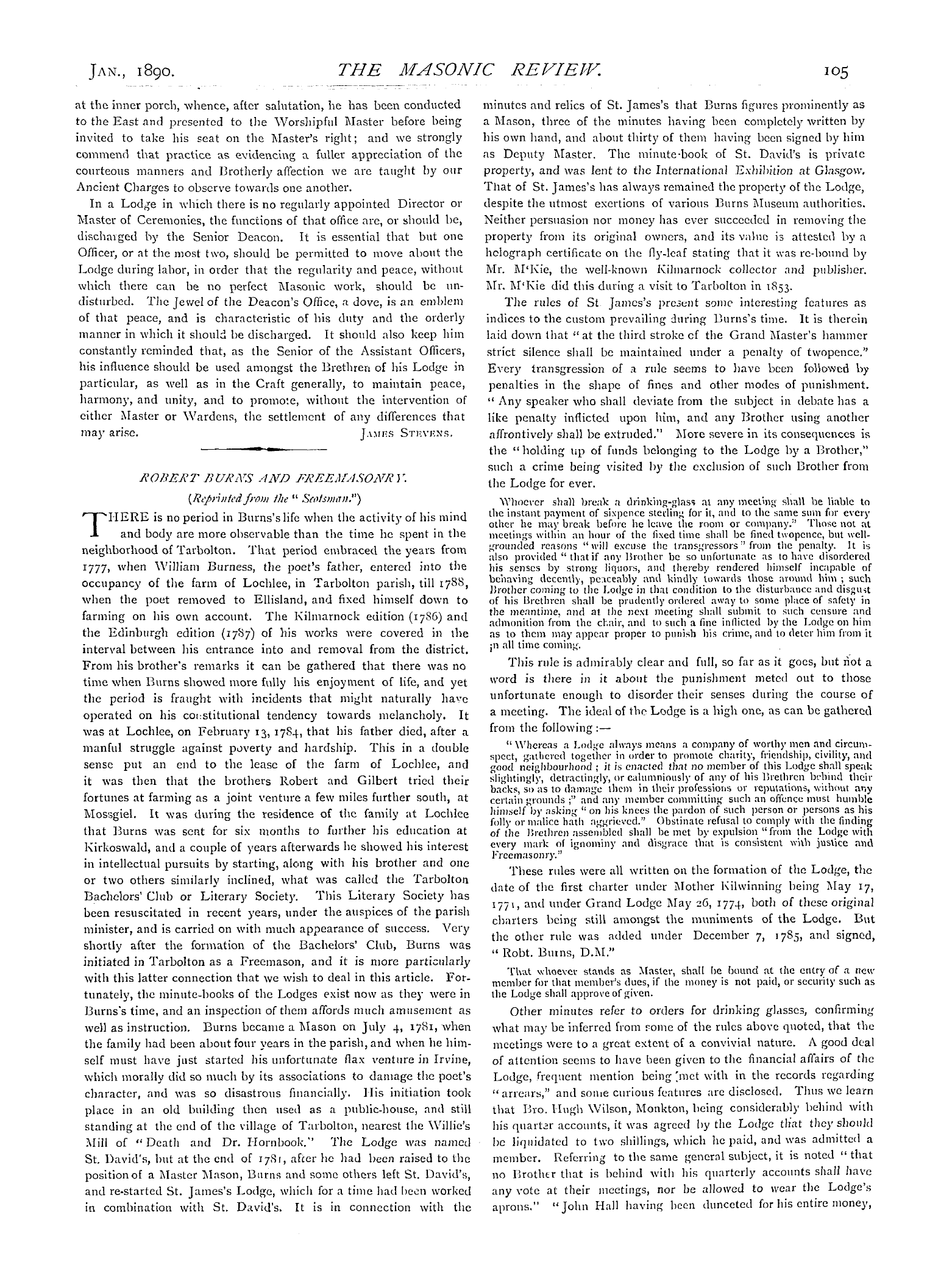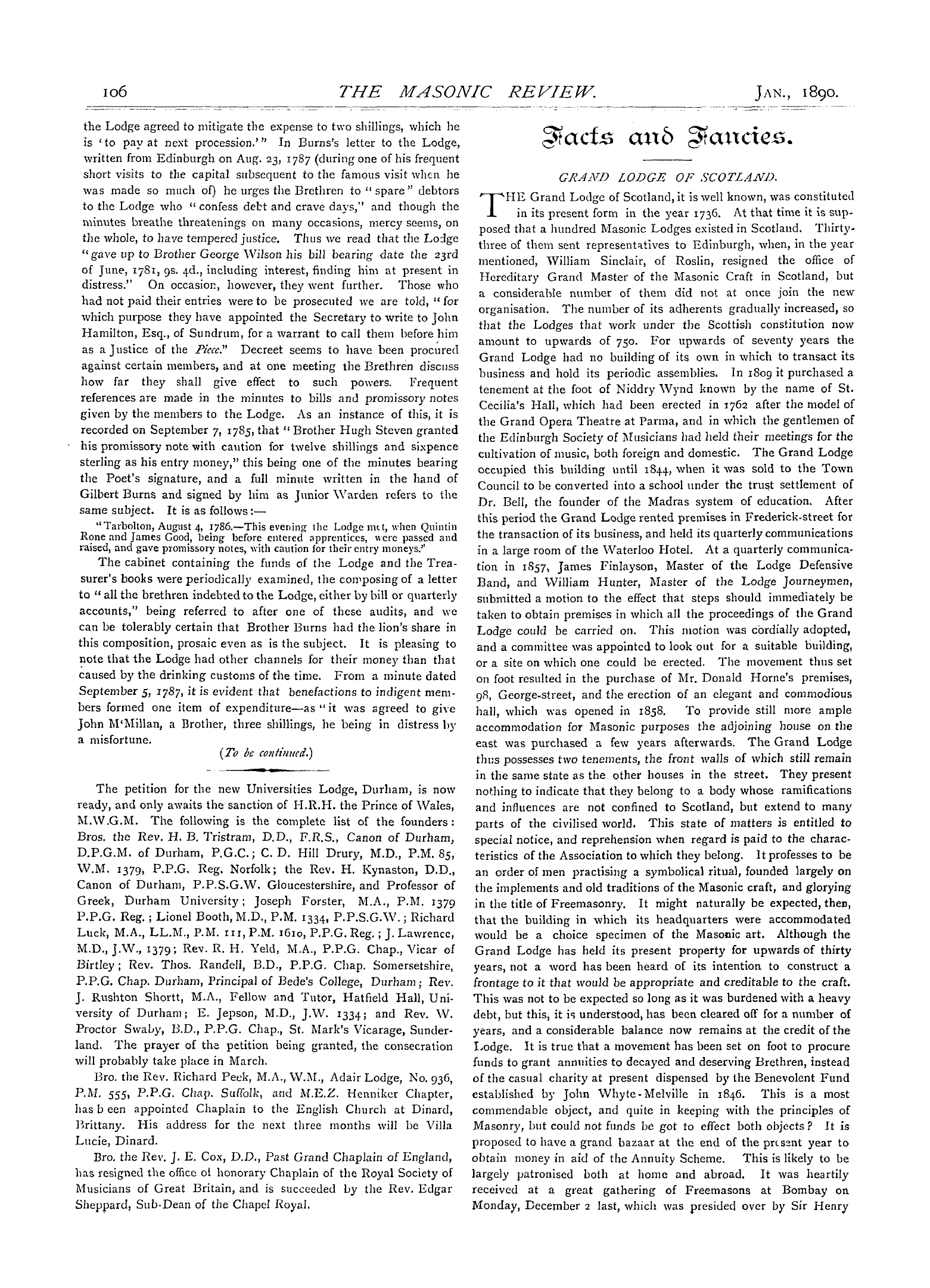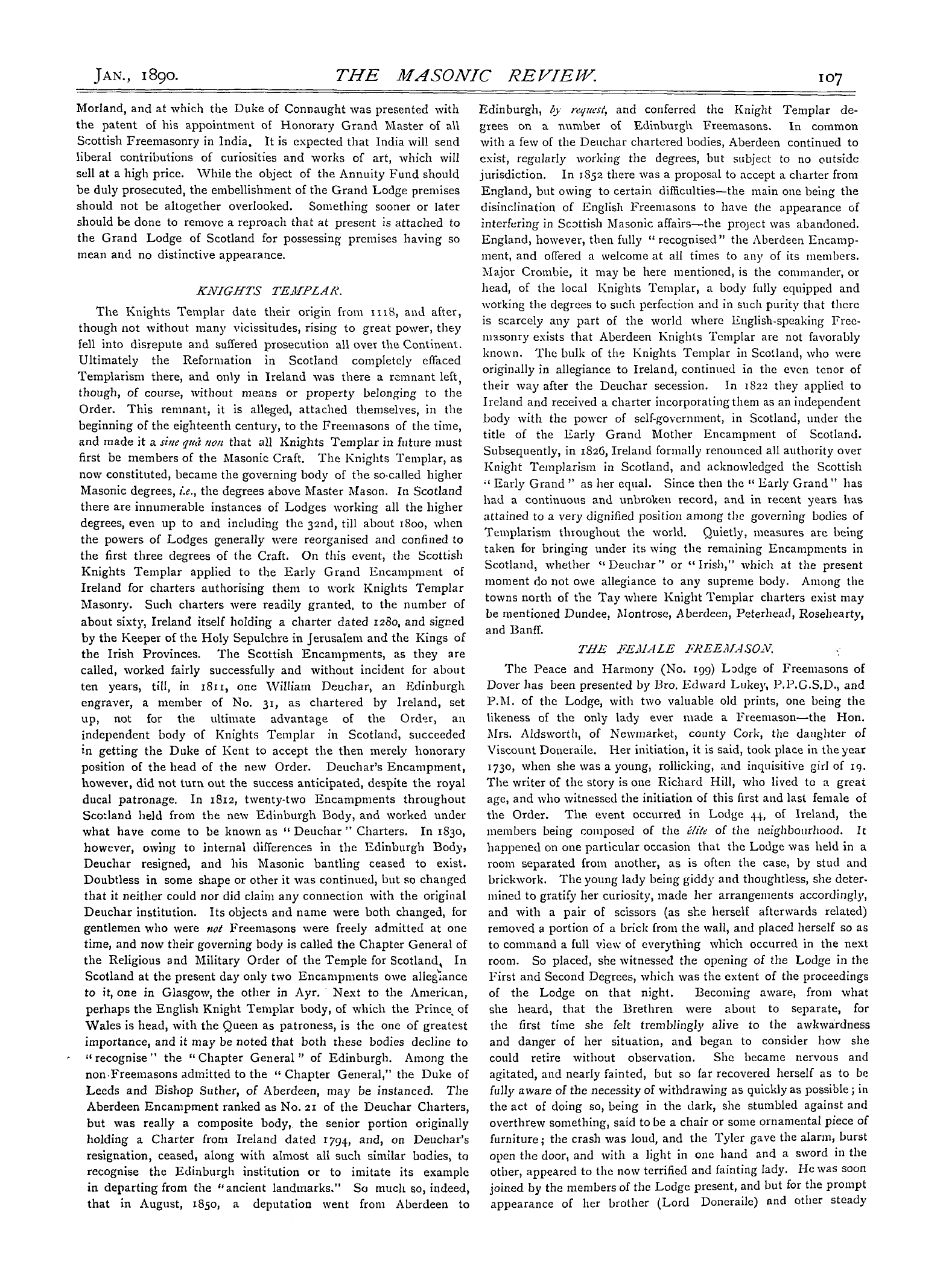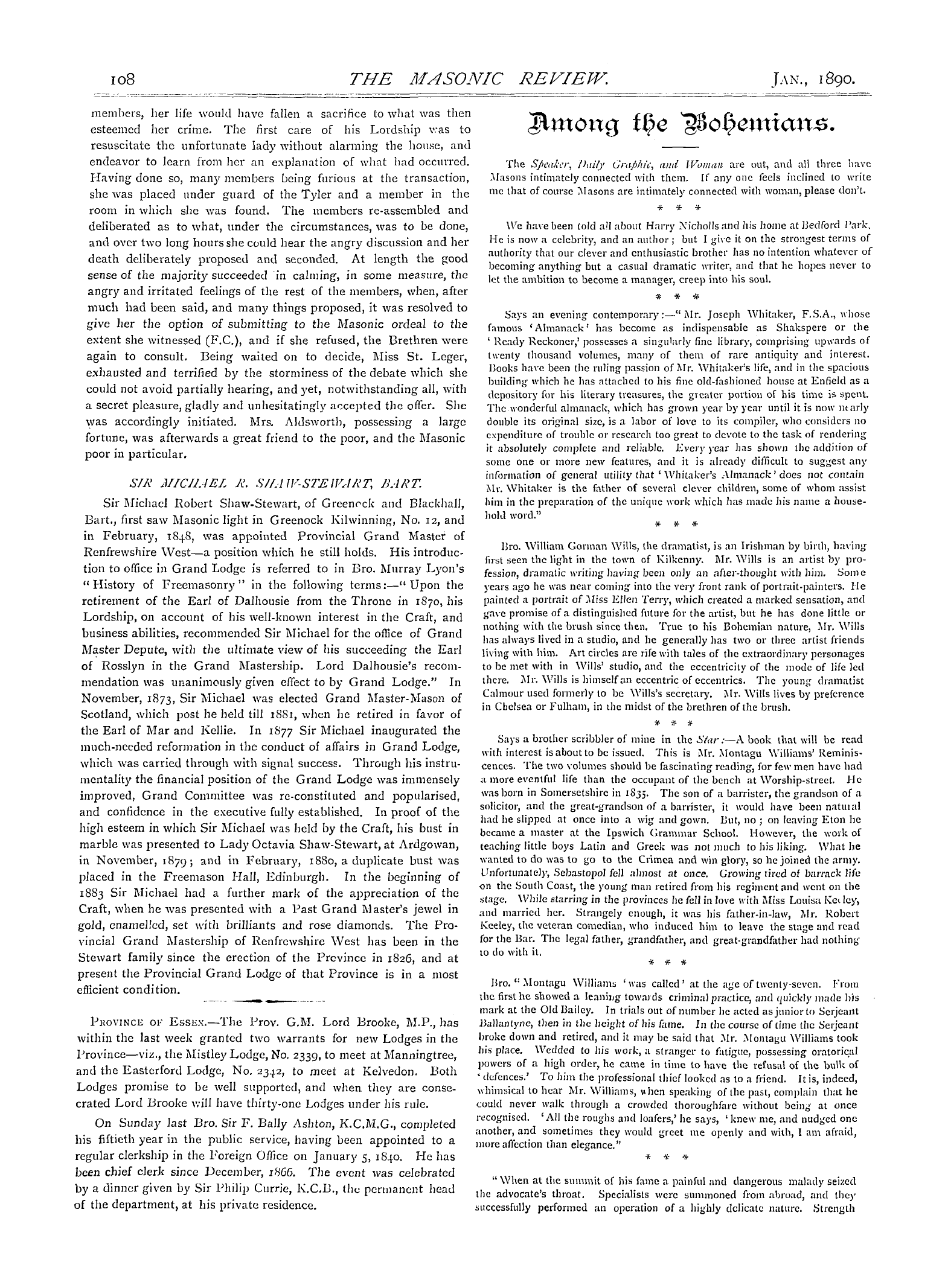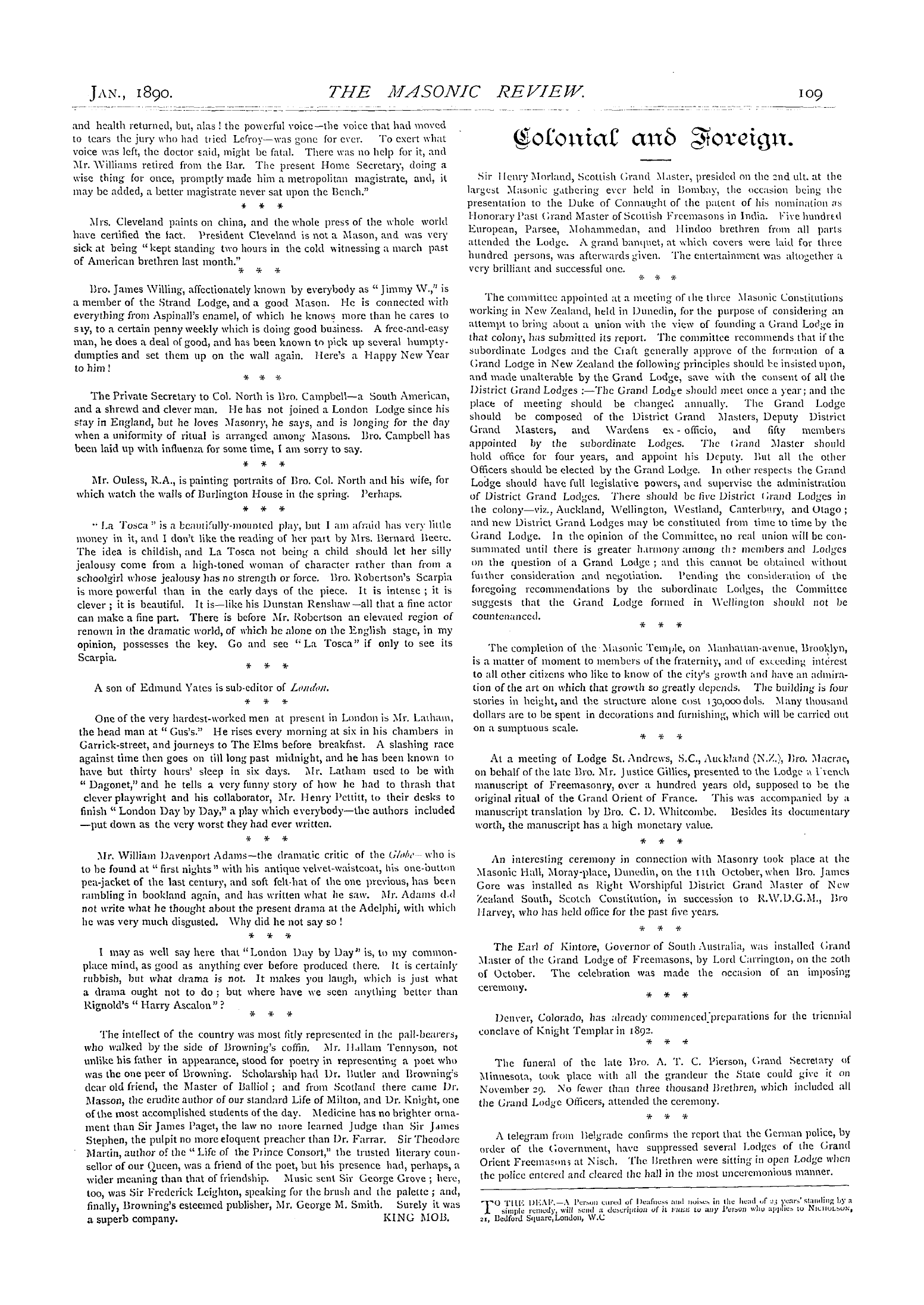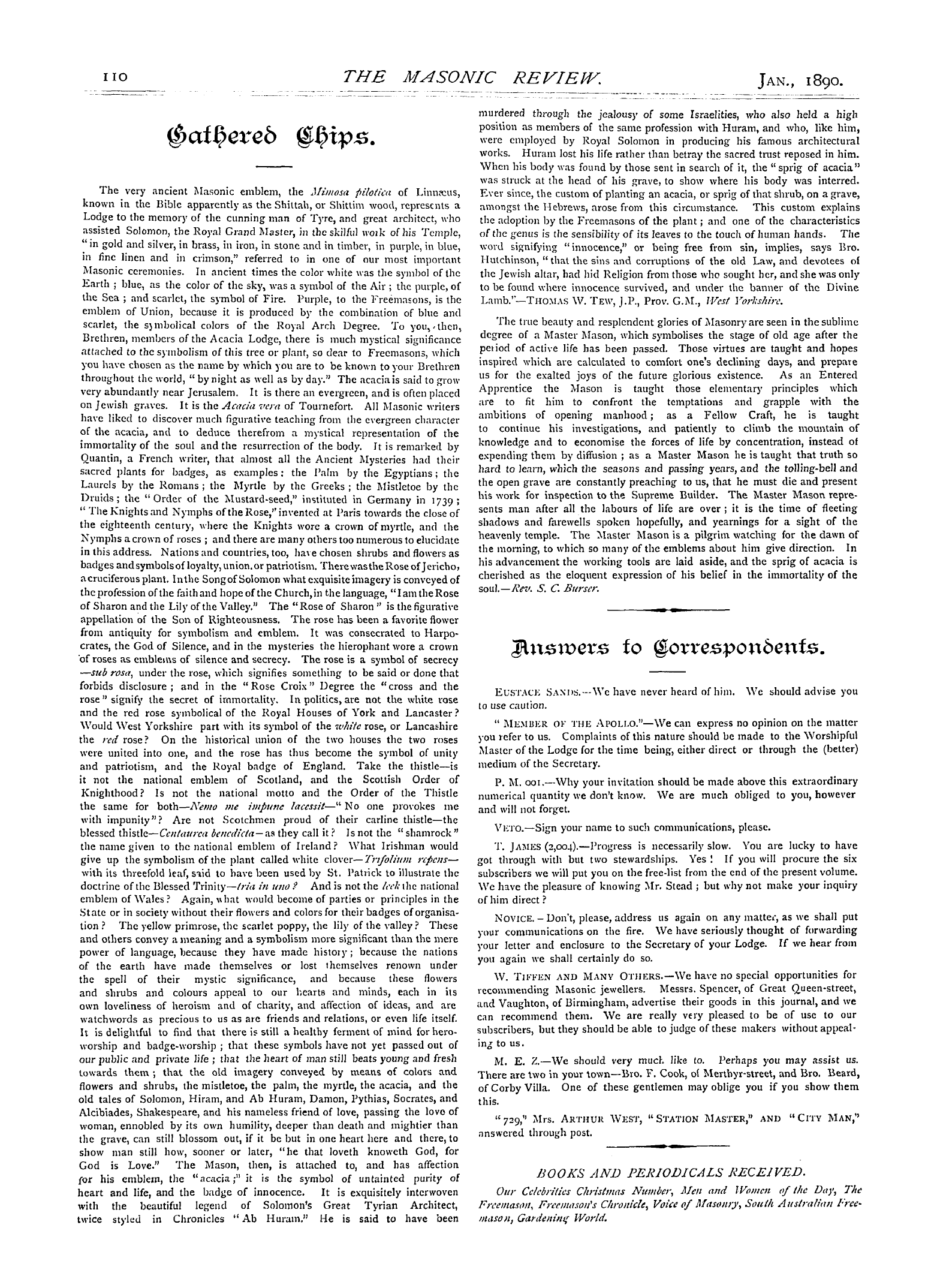-
Articles/Ads
Article Facts and Fancies. ← Page 2 of 3 →
Note: This text has been automatically extracted via Optical Character Recognition (OCR) software.
Facts And Fancies.
Morland , and at which the Duke of Connaught was presented with the patent of his appointment of Honorary Grand Master of aU Scottish Freemasonry in India . It is expected that India will send liberal contributions of curiosities and works of art , which will sell at a high price . While the object of the Annuity Fund should
be duly prosecuted , the embellishment of the Grand Lodge premises should not be altogether overlooked . Something sooner or later should be done to remove a reproach that at present is attached to the Grand Lodge of Scotland for possessing premises having so mean and no distinctive appearance .
KNIGHTS TEMPLAR . The Knights Templar date their origin from m 8 , and after , though not without many vicissitudes , rising to great power , they fell into disrepute and suffered prosecution all over the Continent . Ultimately the Reformation in Scotland completely effaced
Templarism there , and only in Ireland was there a remnant left though , of course , without means or property belonging to the Order . This remnant , it is alleged , attached themselves , in the beginning of the eighteenth century , to the Freemasons of the time , and made it a sine qua tio / i that all Knights Templar in future must
first be members of the Masonic Craft . The Knights Templar , as now constituted , became the governing body of the so-called higher Masonic degrees , i . e ., the degrees above Master Mason . In Scotland there are innumerable instances of Lodges working all the higher degrees , even up to and including the 32 nd , till about 1800 , when
the powers of Lodges generally were reorganised and confined to the first three degrees of the Craft . On this event , the Scottish Knights Templar applied to the Early Grand Encampment of Ireland for charters authorising them to work Knights Templar Masonry . Such charters were readily granted , to the number of
about sixty , Ireland itself holding a charter dated 1280 , and signed by the Keeper of the Holy Sepulchre in Jerusalem and the Kings of the Irish Provinces . The Scottish Encampments , as they are called , worked fairly successfully and without incident for about ten years , till , in 1811 , one William Deuchar , an Edinburgh
engraver , a member of No . 31 , as chartered by Ireland , set up , not for the ultimate advantage of the Order , an independent body of Knights Templar in Scotland , succeeded in getting the Duke of Kent to accept the then merely honorary position of the head of the new Order . Deuchar ' s Encampment , however , did not turn out the success anticipated , despite the royal
ducal patronage . In 1812 , twenty-two Encampments throughout Scotland held from the new Edinburgh Body , and worked under what have come to be known as " Deuchar " Charters . In 1830 , however , owing to internal differences in the Edinburgh Body , Deuchar resigned , and his Masonic bantling ceased to exist .
Doubtless in some shape or other it was continued , but so changed that it neither could nor did claim any connection with the original Deuchar institution . Its objects and name were both changed , for gentlemen who were not Freemasons were freely admitted at one time , and now their governing body is called the Chapter General of
the Religious and Military Order of the Temple for Scotland ^ In Scotland at the present day only two Encampments owe allegiance to it , one in Glasgow , the other in Ayr . Next to the American , perhaps the English Knight Templar body , of which the Prince , of Wales is head , with the Queen as patroness , is the one of greatest importance , and it may be noted that both these bodies decline to
" recognise" the " Chapter General" of Edinburgh . Among the non-Freemasons admitted to the " Chapter General , " the Duke of Leeds and Bishop Suther , of Aberdeen , may be instanced . The Aberdeen Encampment ranked as No . 21 of the Deuchar Charters , but was really a composite body , the senior portion originally
holding a Charter from Ireland dated 1794 , an < ^> on Deuchar ' s resignation , ceased , along with almost all such similar bodies , to recognise the Edinburgh institution or to imitate its example in departing from the " ancient landmarks . " So much so , indeed , that in August , 1850 , a deputation went from Aberdeen to
Edinburgh , by request , and conferred the Knight Templar degrees on a number of Edinburgh Freemasons . In common with a few of the Deuchar chartered bodies , Aberdeen continued to exist , regularly working the degrees , but subject to no outside jurisdiction . In 1852 there was a proposal to accept a charter from
England , but owing to certain difficulties—the main one being the disinclination of English Freemasons to have the appearance of interfering in Scottish Masonic affairs—the project was abandoned . England , however , then fully " recognised " the Aberdeen Encampment , and offered a welcome at ail times to any of its members .
Major Crombie , it may be here mentioned , is the commander , or head , of the local Knights Templar , a body fully equipped and working the degrees to such perfection and in such purity that there is scarcely any part of the world where English-speaking Freemasonry exists that Aberdeen Knights Templar are not favorably known . The bulk of the Knights Templar in Scotland , who were
originally in allegiance to Ireland , continued in the even tenor of their way after the Deuchar secession . In 1822 they applied to Ireland and received a charter incorporating them as an independent body with the power of self-government , in Scotland , under the title of the Early Grand Mother Encampment of Scotland .
Subsequently , in 1826 , Ireland formally renounced all authority over Knight Templarism in Scotland , and acknowledged the Scottish ' Early Grand " as her equal . Since then the " Early Grand " has had a continuous and unbroken record , and in recent years has attained to a very dignified position among the governing bodies of
Templarism throughout the world . Quietly , measures are being taken for bringing under its wing the remaining Encampments in Scotland , whether " Deuchar" or " Irish , " which at the present moment do not owe allegiance to any supreme body . Among the towns north of the Tay where Knight Templar charters exist may be mentioned Dundee , Montrose , Aberdeen , Peterhead , Rosehearty , and Banff .
THE FEMALE FREEMASON . The Peace and Harmony ( No . 199 ) Lodge of Freemasons of Dover has been presented by Bro . Edward Luke } ' , P . P . G . S . D ., and P . M . of the Lodge , with two valuable old prints , one being the likeness of the only lady ever made a Freemason—the Hon .
Mrs . Aldsworth , of Newmarket , county Cork , the daughter of Viscount Doneraile . Her initiation , it is said , took place in the year 1730 , when she was a young , rollicking , and inquisitive girl of 19 . The writer of the story is one Richard Hill , who lived to a great age , and who witnessed the initiation of this first and last female of
the Order . The . event occurred in Lodge 44 , of Ireland , the members being composed of the elite of the neighbourliood . It happened on one particular occasion that the Lodge was held in a room separated from another , as is often the case , by stud and brickwork . The young lady being giddy and thoughtless , she
determined to gratify her curiosity , made her arrangements accordingly , and with a pair of scissors ( as she herself afterwards related ) removed a portion of a brick from the wall , and p laced herself so as
to command a full view of everything which occurred in the next room . So placed , she witnessed the opening of the Lodge in the First and Second Degrees , which was the extent of the proceedings of the Lodge on that night . Becoming aware , from what she heard , that the Brethren were about to separate , for the first time she felt tremblingly alive to the awkwardness
and danger of her situation , and began to consider how she could retire without observation . She became nervous and agitated , and nearly fainted , but so far recovered herself as to be fully aware of the necessity of withdrawing as quickly as possible ; in the act of doing so , being in the dark , she stumbled against and
overthrew something , said to be a chair or some ornamental piece of furniture ; the crash was loud , and the Tyler gave the alarm , burst open the door , and with a light in one hand and a sword in the other , appeared to the now terrified and fainting lady . He was soon joined by the members of the Lodge present , and but for the prompt appearance of her brother ( Lord Doneraile ) and other steady
Note: This text has been automatically extracted via Optical Character Recognition (OCR) software.
Facts And Fancies.
Morland , and at which the Duke of Connaught was presented with the patent of his appointment of Honorary Grand Master of aU Scottish Freemasonry in India . It is expected that India will send liberal contributions of curiosities and works of art , which will sell at a high price . While the object of the Annuity Fund should
be duly prosecuted , the embellishment of the Grand Lodge premises should not be altogether overlooked . Something sooner or later should be done to remove a reproach that at present is attached to the Grand Lodge of Scotland for possessing premises having so mean and no distinctive appearance .
KNIGHTS TEMPLAR . The Knights Templar date their origin from m 8 , and after , though not without many vicissitudes , rising to great power , they fell into disrepute and suffered prosecution all over the Continent . Ultimately the Reformation in Scotland completely effaced
Templarism there , and only in Ireland was there a remnant left though , of course , without means or property belonging to the Order . This remnant , it is alleged , attached themselves , in the beginning of the eighteenth century , to the Freemasons of the time , and made it a sine qua tio / i that all Knights Templar in future must
first be members of the Masonic Craft . The Knights Templar , as now constituted , became the governing body of the so-called higher Masonic degrees , i . e ., the degrees above Master Mason . In Scotland there are innumerable instances of Lodges working all the higher degrees , even up to and including the 32 nd , till about 1800 , when
the powers of Lodges generally were reorganised and confined to the first three degrees of the Craft . On this event , the Scottish Knights Templar applied to the Early Grand Encampment of Ireland for charters authorising them to work Knights Templar Masonry . Such charters were readily granted , to the number of
about sixty , Ireland itself holding a charter dated 1280 , and signed by the Keeper of the Holy Sepulchre in Jerusalem and the Kings of the Irish Provinces . The Scottish Encampments , as they are called , worked fairly successfully and without incident for about ten years , till , in 1811 , one William Deuchar , an Edinburgh
engraver , a member of No . 31 , as chartered by Ireland , set up , not for the ultimate advantage of the Order , an independent body of Knights Templar in Scotland , succeeded in getting the Duke of Kent to accept the then merely honorary position of the head of the new Order . Deuchar ' s Encampment , however , did not turn out the success anticipated , despite the royal
ducal patronage . In 1812 , twenty-two Encampments throughout Scotland held from the new Edinburgh Body , and worked under what have come to be known as " Deuchar " Charters . In 1830 , however , owing to internal differences in the Edinburgh Body , Deuchar resigned , and his Masonic bantling ceased to exist .
Doubtless in some shape or other it was continued , but so changed that it neither could nor did claim any connection with the original Deuchar institution . Its objects and name were both changed , for gentlemen who were not Freemasons were freely admitted at one time , and now their governing body is called the Chapter General of
the Religious and Military Order of the Temple for Scotland ^ In Scotland at the present day only two Encampments owe allegiance to it , one in Glasgow , the other in Ayr . Next to the American , perhaps the English Knight Templar body , of which the Prince , of Wales is head , with the Queen as patroness , is the one of greatest importance , and it may be noted that both these bodies decline to
" recognise" the " Chapter General" of Edinburgh . Among the non-Freemasons admitted to the " Chapter General , " the Duke of Leeds and Bishop Suther , of Aberdeen , may be instanced . The Aberdeen Encampment ranked as No . 21 of the Deuchar Charters , but was really a composite body , the senior portion originally
holding a Charter from Ireland dated 1794 , an < ^> on Deuchar ' s resignation , ceased , along with almost all such similar bodies , to recognise the Edinburgh institution or to imitate its example in departing from the " ancient landmarks . " So much so , indeed , that in August , 1850 , a deputation went from Aberdeen to
Edinburgh , by request , and conferred the Knight Templar degrees on a number of Edinburgh Freemasons . In common with a few of the Deuchar chartered bodies , Aberdeen continued to exist , regularly working the degrees , but subject to no outside jurisdiction . In 1852 there was a proposal to accept a charter from
England , but owing to certain difficulties—the main one being the disinclination of English Freemasons to have the appearance of interfering in Scottish Masonic affairs—the project was abandoned . England , however , then fully " recognised " the Aberdeen Encampment , and offered a welcome at ail times to any of its members .
Major Crombie , it may be here mentioned , is the commander , or head , of the local Knights Templar , a body fully equipped and working the degrees to such perfection and in such purity that there is scarcely any part of the world where English-speaking Freemasonry exists that Aberdeen Knights Templar are not favorably known . The bulk of the Knights Templar in Scotland , who were
originally in allegiance to Ireland , continued in the even tenor of their way after the Deuchar secession . In 1822 they applied to Ireland and received a charter incorporating them as an independent body with the power of self-government , in Scotland , under the title of the Early Grand Mother Encampment of Scotland .
Subsequently , in 1826 , Ireland formally renounced all authority over Knight Templarism in Scotland , and acknowledged the Scottish ' Early Grand " as her equal . Since then the " Early Grand " has had a continuous and unbroken record , and in recent years has attained to a very dignified position among the governing bodies of
Templarism throughout the world . Quietly , measures are being taken for bringing under its wing the remaining Encampments in Scotland , whether " Deuchar" or " Irish , " which at the present moment do not owe allegiance to any supreme body . Among the towns north of the Tay where Knight Templar charters exist may be mentioned Dundee , Montrose , Aberdeen , Peterhead , Rosehearty , and Banff .
THE FEMALE FREEMASON . The Peace and Harmony ( No . 199 ) Lodge of Freemasons of Dover has been presented by Bro . Edward Luke } ' , P . P . G . S . D ., and P . M . of the Lodge , with two valuable old prints , one being the likeness of the only lady ever made a Freemason—the Hon .
Mrs . Aldsworth , of Newmarket , county Cork , the daughter of Viscount Doneraile . Her initiation , it is said , took place in the year 1730 , when she was a young , rollicking , and inquisitive girl of 19 . The writer of the story is one Richard Hill , who lived to a great age , and who witnessed the initiation of this first and last female of
the Order . The . event occurred in Lodge 44 , of Ireland , the members being composed of the elite of the neighbourliood . It happened on one particular occasion that the Lodge was held in a room separated from another , as is often the case , by stud and brickwork . The young lady being giddy and thoughtless , she
determined to gratify her curiosity , made her arrangements accordingly , and with a pair of scissors ( as she herself afterwards related ) removed a portion of a brick from the wall , and p laced herself so as
to command a full view of everything which occurred in the next room . So placed , she witnessed the opening of the Lodge in the First and Second Degrees , which was the extent of the proceedings of the Lodge on that night . Becoming aware , from what she heard , that the Brethren were about to separate , for the first time she felt tremblingly alive to the awkwardness
and danger of her situation , and began to consider how she could retire without observation . She became nervous and agitated , and nearly fainted , but so far recovered herself as to be fully aware of the necessity of withdrawing as quickly as possible ; in the act of doing so , being in the dark , she stumbled against and
overthrew something , said to be a chair or some ornamental piece of furniture ; the crash was loud , and the Tyler gave the alarm , burst open the door , and with a light in one hand and a sword in the other , appeared to the now terrified and fainting lady . He was soon joined by the members of the Lodge present , and but for the prompt appearance of her brother ( Lord Doneraile ) and other steady
